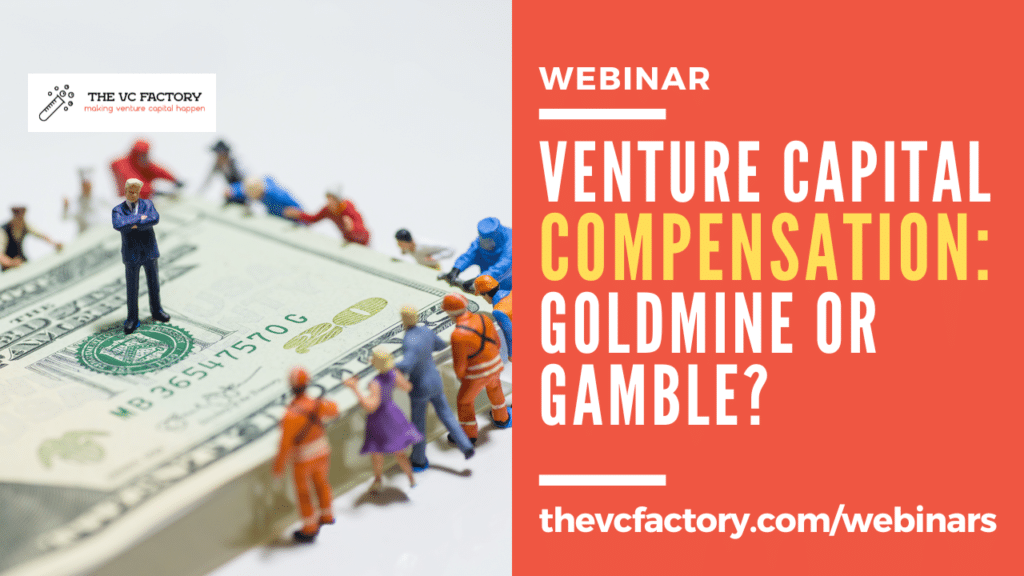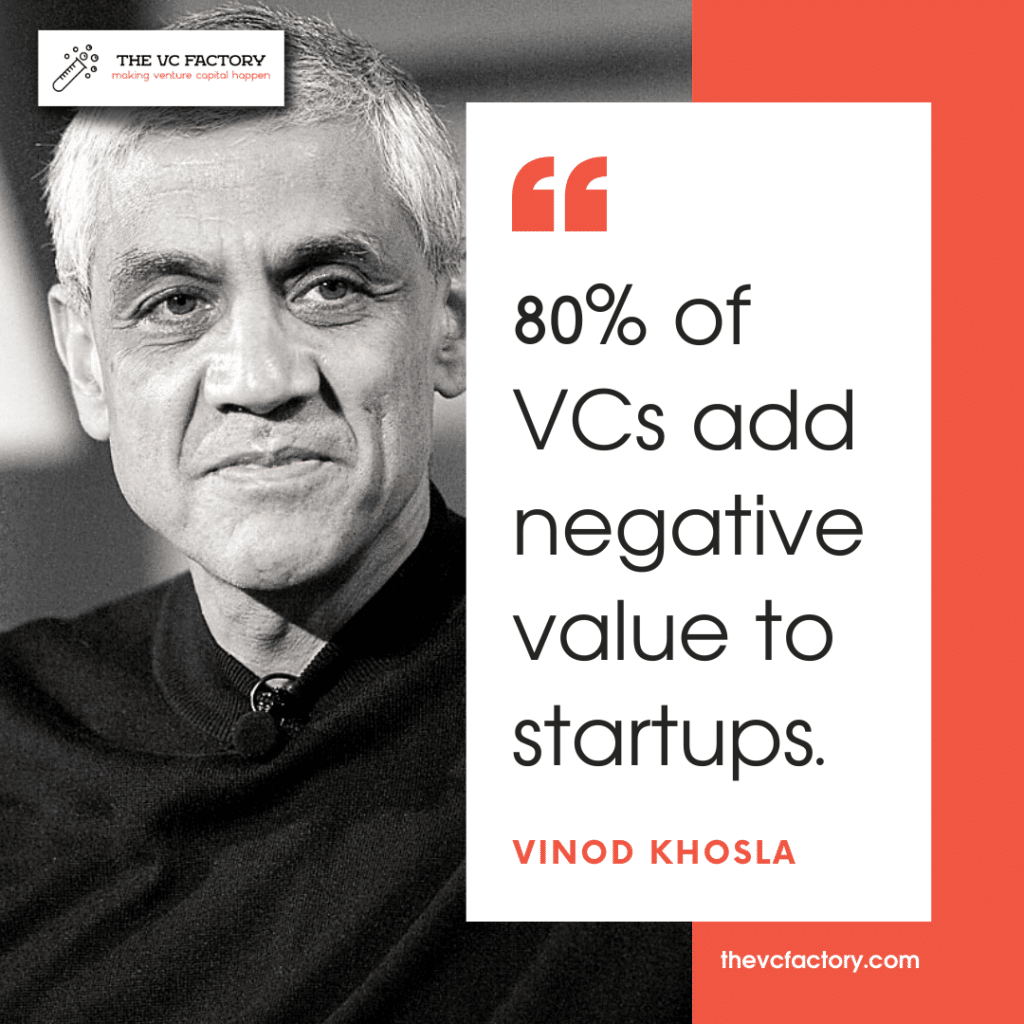Venture Capital Compensation – Goldmine or Gamble?
- 1.9K views
- 25 minute read

Understanding how Venture Capital compensation works is akin to deciphering a complex puzzle, with various pieces including salaries, bonuses, carried interest, and attached terms. Factors like seniority, location, firm size, and market cycles play crucial roles. While the allure of VC as a career path is undeniable, with its promise of engaging with cutting-edge technologies, the potential for substantial financial rewards varies highly. Is pursuing a career in Venture Capital solely for the monetary gain advisable, or are there other, more fulfilling reasons to venture into this field?
In this article and its companion webinar, I shed light on the multifaceted nature of VC compensation, breaking down the mechanisms through which VC funds generate income for their managers. I dissect the various components that make up a Venture Capitalist's earnings, from the famed 2/20 rule to the key terms and conditions that influence compensation, such as GP commit, hurdle rate, vesting, and the dynamics of the proceeds waterfall.
In This Post
- How VC Funds Make Money
- Strings Attached To Venture Capital Compensation
- Venture Capital Compensation Packages
- Is Venture Capital Compensation Enough To Validate The VC Career Choice?
- Conclusion: Do Venture Capital For The Job, Not The Money
Accelerate Your Learning: Watch Our Webinar!
Don’t just read about it, immerse yourself in the content through our companion webinar for this post! Engage with a multimedia presentation, discover all the referenced sources, and have your questions answered live! Click the “Watch Now” button to access the webinar. (Members: click here).

How VC Funds Make Money
This section describes the economic foundations of Venture Capital funds, starting with the LP/GP structure and expanding to the famous "2/20" compensation mechanism in vogue in private equity.
Foundations of VC Economics: The LP/GP Structure and the 2/20 Rule
Most VC funds follow the Limited Partner (LP)/General Partner (GP) model, a cornerstone shaping how VC funds operate and profit. LPs are the investors who provide the capital for the fund, while GPs are the Venture Capitalists who manage the investments. Read the article below if you're unfamiliar with this model and want to grasp the implications for VC firms' deployment strategy.
The "2/20 rule" is an industry-standard compensation structure where GPs receive a 2% management fee on the total assets under management (AUM) and a 20% carried interest (or "carry") on the profits generated by the fund beyond a specified return threshold. This framework aligns the interests of GPs and LPs, incentivizing GPs to maximize the fund's performance.
While the 2/20 structure is widely regarded as the standard in Venture Capital compensation, there's significant variability based on fund size, strategy, and negotiation dynamics.
Emerging managers, keen on aligning their interests with the long-term success of their investments, may opt for a structure emphasizing carried interest over management fees. This entrepreneurial approach incentivizes the creation of substantial value.
Smaller funds might levy higher management fees, sometimes deviating from the traditional 2% to adequately cover operational expenses, given their smaller asset base.
Lead Investors, particularly those looking to bring co-Investors into deals, might negotiate a 1/10 structure. This arrangement may improve a deal's economics as they will charge co-Investors 1% management fee and 10% carried.
These variations underscore the flexibility within VC fund structures, tailored to balance the fund's operational needs with the incentive to drive significant returns. Further details on the management fees and carry follow.
Management Fees: The Engine of VC Operations
Management fees serve as the operational backbone for VC funds, covering the day-to-day expenses and allowing GPs to scout, invest in, and support promising startups. Typically set at around 2% of the fund's AUM, these fees ensure that the fund's management operations are financially sustainable, regardless of the fund's investment success.
Basic Venture Capital Compensation Is Based On Management Fees
Management fees are collected by the operating company responsible for the fund's management. They are debited from the capital calls, usually every quarter, to cover substantial costs such as:
- Salaries and Compensation: Human capital is a significant expense, as VC salaries are substantial. The fund's talent commands high compensation for their expertise and skills.
- Operational Infrastructure: This includes the costs associated with physical office space (real estate) and the technology required to evaluate and monitor investments.
- Professional Services: Accounting and auditing services are necessary for the fund's financial integrity and compliance with regulations.
- Annual Gatherings: Funds typically host an annual meeting for LPs to report on performance, strategy, and portfolio company updates.
However, it is noteworthy that not all expenses are covered by the management fee. For instance, the portfolio companies typically bear travel expenses to board meetings, and the fund may absorb certain fundraising expenses at the point of its closing.
Committed vs. Invested
Management fees in Venture Capital can be structured based on committed or invested capital, each with its own implications. When fees are based on committed capital, the fund charges fees on the total amount pledged by LPs, regardless of whether that capital is currently invested in portfolio companies. This method ensures a predictable revenue stream for the fund's operations but can be a point of contention for LPs when a large portion of their commitment is not yet deployed.
On the other hand, fees based on invested capital are charged only on the portion of LPs' commitments that have been deployed into investments. It aligns the GP's revenue more closely with the fund's activity level, potentially incentivizing more informed investment decisions. However, it can also lead to a less stable operational budget for the fund, especially in the early years when it is not fully invested.
If management fees are calculated on invested capital, then LPs are fine beging patient and respecting the discipline of the manager.
Hunter Sommerville - Stepstone (Source: 20VC)
A potential misalignment emerges when VC markets slow down. GPs accumulate substantial undeployed capital ("dry powder"), which raises questions about their ability to efficiently call and invest this capital, especially in a challenging market.
In such environments, VC firms shouldn't rush to deploy their current fund's capital to return to the market for more fundraising. However, concerns arise regarding how long these firms can justifiably "sit" on uninvested capital.
This is where the fee structure becomes critical. Hunter Sommerville, a partner at secondary buyer Stepstone, recently made the case that if management fees are based on invested capital, LPs may be more willing to be patient and respect the fund managers' discipline in not hastily deploying capital. But if fees are on committed capital, the situation could become problematic, as LPs pay fees on idle money.
I disagree with Hunter's position.
Basing the fee structure on invested capital may incentivize Venture Capitalists to deploy capital more aggressively. Since their management fee earnings are tied to the amount of capital put to work, GPs could be motivated to invest more rapidly, potentially compromising the due diligence process or investing in less-than-ideal opportunities.
This could lead to a misalignment of interests, where the focus shifts from seeking quality investments that promise long-term growth to prioritizing the quantity of investments to secure management fees. It's an argument for careful consideration, as it underscores the delicate balance between incentivizing GPs and ensuring disciplined investment strategies that protect the long-term interests of the LPs.
Carried Interest: The Reward for Successful Investments
Carried interest or "carry," typically representing 20% of the fund's capital gains, is a critical part of the Venture Capital compensation package and the primary source of potential wealth for Venture Capitalists.
This performance-based compensation rewards GPs for generating returns that exceed the fund's hurdle rate (see details below), acting as a powerful incentive for GPs to identify and nurture high-growth ventures. The intricacies of carried interest calculations, including catch-up provisions and waterfall structures, directly impact the final compensation GPs receive from successful exits.
Carried Interest Calculation
Let's take an example assuming the following conditions for the Venture Capital fund:
- Total Committed Capital: $100 million (for simplicity, let's assume all committed capital is invested)
- Total Exit Proceeds: $300 million
- Carried Interest Rate: 20%
- Hurdle Rate: 8%, cleared (see below)
Here's the carried interest calculation:
Capital Gains: The gains are the total exit proceeds minus the committed capital. In this case, $300 million - $100 million = $200 million.
Carried Interest: As the gains exceed the hurdle amount, the GP is entitled to a 20% carried interest or 20% of $200 million, which is $40 million.
Two notions matter here. First, proceeds are different from gains. Carry is calculated on how much capital GPs create beyond the LPs' commitments, not the committed capital. As we'll see later in this post, management fees impact the money at work, so most GPs will negotiate the possibility of "recycling management fees."
Second, while most professionals will refer to capital gains as profits, this is incorrect. Capital gains are a balance sheet item, while profits are an income statement item.
Does Venture Capital Compensation Reflect Value-Add?
Carried interest exists as a fundamental component of Venture Capital compensation to align the financial interests of the GPs with the performance of the investments they manage. It serves as a powerful incentive mechanism for several reasons:
Performance Incentive: As mentioned before, carried interest is a reward for the GPs if the fund performs well. Since it is a share of the profits, GPs only receive this compensation after returning the initial capital and, often, after surpassing a predefined hurdle rate. This structure motivates GPs to seek out investments that will yield high returns, as their earnings are directly tied to the success of their portfolio companies.
Superior Deal Sourcing: Venture Capitalists are constantly in pursuit of high-potential startups. Carried interest incentivizes them to use their expertise, networks, and resources to identify and secure the best deals. It rewards the skill involved in deal sourcing—finding those rare investment opportunities that could lead to outsized returns.
Value Addition: Beyond identifying promising deals, Venture Capitalists are expected to actively contribute to their investments' growth and success. This involves providing strategic guidance, mentoring management, facilitating partnerships and customer relationships, and assisting with additional fundraising. Carried interest recognizes and rewards the substantial value that GPs bring to the table, not just through capital but through these active, value-adding engagements.
Long-Term Commitment: The nature of carried interest, typically realized after several years, encourages a long-term perspective. GPs are incentivized to support and nurture their portfolio companies over time rather than seeking quick exits that may not yield the best outcomes.
Risk Sharing: Since carried interest is contingent on the fund's success, GPs share the risk with their LPs. They stand to gain only if the LPs gain, which is a fair proposition for both parties. If the investments do not perform, the GPs receive no carried interest, which can be a significant portion of their potential earnings.
Watch the webinar for real-life examples of VC funds' economic structures.
The Fees vs. Carry Debate: Which One Weighs in More in Venture Capital Compensation?
The balance between Fees (management fees) and Carry (carried interest) is a fundamental debate in VC compensation. Management fees provide immediate, predictable income to manage the fund, whereas carried interest represents potential future profits contingent on the fund's success.
The debate centers on finding the right balance that fairly compensates GPs for their ongoing management efforts while also incentivizing the long-term success of the fund's investments.
I first encountered this issue in the mid-2000s, as I was financing large LBOs, and the private equity sponsors I was working with were raising mega funds with billions of dollars of assets under management. The economics did not incentivize GPs to make outsized returns, as they were making dozens of millions of dollars in management fees. This situation prompted large LPS like Calpers to negotiate lower management fees with GPs they invested in.
A Philosophical Question?
As the VC asset class matured in the last two decades and mega funds arrived here, the same issue arose around Venture Capital compensation structures.
Cendana's Michael Kim recently illustrated the fees vs. carry issue in concrete examples. For example, turning a $50 million fund into a $450 million gain (a 10x return) yields a $90 million carry at a 20% rate. This is comparable to a $500 million fund that doubles in value (a 20% carry would amount to $100 million). While the financial outcome is close, the strategies differ. The choice between pursuing high multiples with smaller funds or achieving more modest ones with larger funds depends on the fund managers' goals, philosophies, and capabilities.
However, missing the target performance has different implications for each manager. In the first case, management fees would amount to a few million dollars (as indicated below, management fee percentages decrease substantially after the end of the investment period). In the second case, the partners would net $10 million yearly, or $75 million over 10 years, assuming the fee goes down to 1% annually after the investment period.
Even with more partners and staff costs typical for a larger fund, GPs in the second case would make a decent living even without overperformance from their portfolio. The limit, naturally, is to be able to raise the next fund.
Management fee is a loan.
Michael Kim - Cendana Capital (Source: the 10x Capital Podcast)
LPs making allocations to VC funds must ponder the fees vs. carry debate thoughtfully.
Michael Kim likens management fees to non-recourse loans, emphasizing the expectation that these fees must be "repaid" through successful fund performance before carry is realized. This perspective aligns GP and LP interests by prioritizing the return of called capital.
In the podcast, he defends the small fund approach, citing Mucker Capital's investment in Honey, acquired by PayPal in 2019 for $4 billion. The $12 million fund made $280 million in proceeds from that single investment, resulting in dozens of millions in carried interest. In contrast, the fund's management fee amounted to a mere $240,000 annually—showcasing how smaller funds can still produce life-changing economic value for fund managers despite lower management fee income.
Management Fees Compound Over Time
It doesn't mean that small funds should forgo management fees entirely. Emerging managers launching micro funds to build traction hope to gradually raise larger funds. When all goes well, a typical trajectory is to raise a first fund of $5 million, then a second one around $20-25 million, and a third one at $50 million.
In that case, even though the management fee decreases over time as a percentage of total assets, the fees collected by these three funds compound over time. Since the costs of managing what remains small funds do not increase substantially, GPs can make a living if they successfully raise follow-on funds.
To illustrate this point, let's assume a hypothetical scenario where a manager oversees three funds of increasing size ($5 million, $20 million, and $50 million) and applies the following management fee structure:
- 3% per annum for the first four years
- 2% per annum for years 5-6
- 1% for years 7-10
This declining fee structure would produce a reliable revenue stream, with the total management fees across three funds amounting to approximately $1.5 million by Year 8.
Watch the webinar for detailed calculations.
You've reached a Members-only area.
Unlock Full Access
Discover exclusive content curated for Venture Capital professionals and enthusiasts. Join our community and gain unlimited access to in-depth articles, expert guest interviews, MBA-level webinars, and networking opportunities.
Register for our 7-Day Free Trial: Click Here
Already a member? Please Log In Below:
Subscribe to our Newsletter
Join 12,000+ VCs & Founders globally who enjoy our weekly digest on Venture Capital. We keep your information confidential and you can unsubscribe at any time. Sweet!

